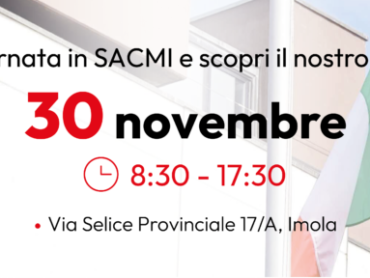Work continues apace at the facility which, once at full capacity, will have a team of at least 30 people performing pure research into enabling technologies and new process control systems. Meanwhile, following the success in Italy, a similar project is now being set up in Spain-based Sacmi Iberica
Developing innovative know-how and enabling technologies with an eye to Industry 4.0. This, in short, is the mission of Sacmi Innovation Lab, the facility established in 2017 and already selected by the Emilia-Romagna Region as a candidate in the first phase of a tender to attract investment in advanced sectors of the region’s industry.
But what are ‘enabling technologies’? “Those ingredients which, if mixed and configured appropriately, create a competitive advantage for the customer”, explains Gildo Bosi, Sacmi’s Automation R&D manager. Following successfully completed projects on the Italian market in 2017, further examples now come from Spain where we’re looking to replicate the positive Innovation Lab experience and provide the local market with a clear reference point.
“Our first project there concerns the development of innovative process control systems“, explains Gildo Bosi, “the aim being to improve product quality control by measuring every parameter during the process cycle”. From body preparation to firing, ceramic manufacturing involves several stages, each of which makes a crucial contribution to optimal finished product quality (and any potential defects). “On the basis of parameter readings and the long term defects database” explains Sacmi’s Automation R&D manager, “it’s possible to create models that correlate defects with their upstream causes. This constitutes a valuable tool for operators as it allows them to enhance their understanding of the ceramic process”.
What’s happened, and why. Two apparently simple questions which the models need to answer: a goal based on so-called “data analytics” (i.e. algorithms based on statistical correlations). “This is the first step”, observes Gildo Bosi, “towards transforming a traditional ceramic plant into a more evolved smart ceramic plant. Of course, the next step consists of anticipating the causes of any defects by implementing predictive diagnostics models”. The aim is to arrive at a point where it is no longer the operator who identifies and corrects the process inefficiency but the plant itself that ‘self-corrects’ via the models.
To this end, Sacmi Innovation Lab doesn’t just focus on identifying enabling technologies: it also, and above all, has the task of training the professionals needed to manage such projects and translate them into winning manufacturing strategies. “That task involves distinctly multi-disciplinary skills that range from IT, mechanical engineering, physics, and chemistry to mathematics (i.e. data scientists), automation and plant management expertise”.
And it’s this ‘managerial’ aspect that leads us to the second major project that Sacmi Innovation Lab is moving ahead with at Sacmi Iberica, one that concerns the efficiency enhancement of machine lines. “When we talk about 4.0”, explains Gildo Bosi, “the focus isn’t merely technological. For example, one of the systems used to transform a traditional ceramic factory into a smart factory involves designing flows and plants innovatively so they reflect the new market logic and provide greater efficiency and economy”. That innovation aims to overhaul the way inventories and flows are managed and reorganise order management systems to cope with the increasing fragmentation of the orders themselves (a consequence of increasing product personalisation, shorter life cycles and smaller volumes). “The sum of these two logics”, observes Sacmi’s Automation R&D manager, “that is, the implementation of new enabling technology and managerial innovation, creates the 4.0 of the future”.
Several pilot plants installed on the Italian market – with some of the Group’s most important customers – follow these new logics. And smart innovation, points out Gildo Bosi, is all the more successful when the technological aptitudes of younger workers are merged with the experience of older ceramists: “New technology is a tool that streamlines people’s work, allowing them to avoid repetitive tasks and dedicate more time to higher-added-value activities. Yet it should always be technology at the service of man, not vice versa. That’s why it’s essential to implement the digital transition so that it makes the most of the ceramic-making experience of those who’ve been with the company a long time”.
Currently staffed by 15 people, the Sacmi Innovation Lab is expected to grow significantly over the next two years, with employee numbers rising to at least 30. “This is a team dedicated exclusively to research, disengaged from production. It is, in fact, precisely when orders and in-company flows are at their height”, concludes Sacmi’s Automation R&D manager, “that we need to sharpen the focus on innovation so we’re ready to meet the next challenge when it comes along”.
Operating in close collaboration with Academy 4.0 – the Sacmi facility that oversees 4.0 learning at every level, from internal training to relations with customers, suppliers, schools and universities – Sacmi Innovation Lab aims to become an Emilia-Romagna High Tech Network node by merging the numerous already-completed projects and existing partnerships with the regional research facility and university system. “In 2017 we hosted 5 dissertation students here in Imola. This year’s goal is to have at least 6-8 dissertation students assigned to the main facility research areas”.


